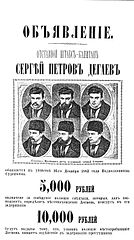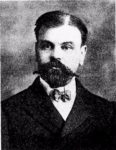As an initial aside, this post embodies what one can learn learn from just one sentence in a book.
While reading The Romanovs, a nearly 800 page tome on the dynasty that ruled Russia for four centuries, there was a paragraph on page 465 about the head of the Narodnaya Volyaan (“People’s Will”), a terrorist group that assassinated Tsar Alexander II in 1861, being a secret police informant. When the group learned that Sergei Degaev had betrayed it, the only way he could save his life was to kill Georgii Sudeikin, the head of the Tsar’s secret police, to whom Degaev had been reporting. On December 16, 1883, he invited Sudeikin to his apartment where he shot him from behind.

Degaev wanted poster
It isn’t a mistake. The USD mathematics professor was indeed Degaev. Somehow, after the assassination, Degaev made it to Paris, where his wife had gone a couple weeks before — on a passport supplied by Sudeikin. The Narodnaya Volyaan expelled him from the movement and barred him from returning to Russia. The latter probably wasn’t much of a penalty. He was being fiercely hunted by Russian authorities, who offered a 10,000 ruble reward (equal to about $200,000 today). Degaev and his wife ended up in St. Louis in 1886. He worked at a chemical plant while she was a laundress and cook. Somewhere along the line they became Alexander and Emma Pell, the names used when they became naturalized citizens in 1891. No one knows why they chose the name Pell.
Pell had earned an engineering degree in Russia. In 1895, he enrolled in a graduate program in mathematics at Johns Hopkins University in Baltimore. He was awarded his doctorate in June 1897. At the time, USD, which held its first classes only 17 years earlier, needed a mathematics professor. By chance, one of Pell’s professors at Johns Hopkins, Lorrain Hulburt, taught at USD from 1887-1891. When USD asked if Hulburt knew of any good candidates, he recommended Pell, although warning of Pell’s “Russian brogue.”
Pell began teaching at USD in the fall of 1897 and quickly became popular among the students. In 1901, the student newspaper described him as the “class father” and “Jolly Little Pell.” It’s been reported several times that when a fight broke out between USD students and fans of an opposing team at a football game in Mitchell the following year, Pell waded into the melee to help the outnumbered USD students. While they triumphed, Pell emerged with a torn shirt and bloodied face. When Emma died in 1904, the students dedicated the yearbook to them.Pell published three academic papers during his first four years at USD but didn’t limit his efforts to mathematics. He urged the school’s board of trustees to start an engineering program. An engineering department was approved in 1903 and opened in 1905. In 1907 the department became the College of Engineering and Pell was its first dean. And while Pell is reported to have said that women didn’t belong in mathematics, he encouraged and supported one of his students, Anna Johnson of Akron, Iowa. After obtaining her USD degree in 1903, Pell helped her pursue graduate studies at the University of Iowa and Radcliffe. In the summer of 1907, Pell traveled to Germany, where Anna was completing a fellowship at the University of Göttingen, and the two were married. She was 24; he was 50.
Pell resigned from USD in 1908, moving to Chicago, where Anna completed her Ph.D. at the University of Chicago. She was the first woman and only the second USD graduate to earn a doctoral degree. She became an extremely well known mathematician. In fact, her biography at a history of mathematics website is longer than his. In 1911, Pell suffered a stroke. She obtained a position at Mount Holyoke College, where they lived until she started teaching at Bryn Mawr College in Pennsylvania in 1918. She ell died in 1921. Anna established a fund for a scholarship at USD and the Dr. Alexander Pell Scholarship is still awarded to mathematics undergrads.
During and after his years at USD, students and faculty were well aware of his work and contributions. Yet they had no clue that “Jolly Little Pell” had been a terrorist assassin. Thus, Degaev/Pell presents an interesting dichotomy. Who was he at heart? Terrorist assassin or respected college professor?
It was not impossible for him to be both. Who wants to be judged solely by certain of their past actions? Moreover, if changes in our lives don’t produce seeming discrepancies then it’s doubtful there’s been real change. Degaev may be a bigger footnote in Russian history than Pell in American history but it’s hard to imagine having experienced such a far-reaching metamorphosis.
Send your Russian mathematician along, brogue and all.
USD wire to Lorrain Hulburt, in Richard Pipes,
The Degaev Affair: Terror and Treason in Tsarist Russia








